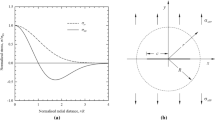Abstract
The stress-strain state of a rectangular plate with a central circular hole and a disk with an edge notch is examined in both the elastic and elastoplastic statement. The stress intensity factors at the tips of cracks emerging from the hole and notch are determined. Parameters describing the process of crack initiation and development are established in the zone of the stress risers. The results of calculations are compared with experimental data in evaluating the period of macrocrack initiation.
Similar content being viewed by others
Literature cited
V. V. Panasyuk, “Deformation criteria in fracture mechanics,” Fiz.-khim. Mekh. Mater., No. 1, 7–23 (1986).
V. T. Troshchenko, V. V. Pokrovskii, and V. G. Kaplunenko, “Effect of specimen dimensions on the characteristics of cyclic crack resistance of thermally stable steels. Report 1,” Probl. Prochn., No. 4, 3–19 (1986).
F. Erdogan and M. Bakioglu, “Crack opening stretch in plot of finite width,” Int. J. Fract.,16, No. 6, 1031–1039 (1975).
D. J. Hayes and J. G. Williams, “The determination of dugdale model solutions,” Int. J. Fract. Mech.,8, No. 3, 239–256 (1972).
A. E. Andreikiv, V. V. Panasyuk, and I. N. Pan'ko, “Theory of the limiting equilibrium of cylindrical specimens with external circular cracks,” Fiz.-khim. Mekh. Mater., No. 3, 29–39 (1974).
S. Ya. Yarema, G. S. Krestin, and A. I. Zboromirskii, “The opening and limiting equilibrium of a crack in an elastoplastic disk,” Fiz.-khim. Mekh. Mater., No. 1, 31–36 (1975).
A. I. Zboromirs'kii, G. S. Ivanits'ka, M. V. Ivanovich, et al., “Pryzhnoplastichna rivnovaga disca zkraiovoyu trishchinoyu,” Fiz.-khim. Mekh. Mater., No. 1, 38–46 (1990).
M. P. Savruk, P. N. Osiv, and I. V. Prokopchuk, Numeric Analysis in Plane Problems of Crack Theory [in Russian], Naukova Dumka, Kiev (1989).
S. E. Kovchik and E. M. Morozov, Fracture Mechanics and Strength of Materials: Reference Manual. in four volumes, V. V. Panasyuk (ed.), Characteristics of Short-Term Crack Resistance of Materials and Methods of Their Determination [in Russian], Vol. 3, Naukova Dumka, Kiev (1988).
V. V. Panasyuk, “On modern problems of fracture mechanics,” Fiz.-khim. Mekh. Mater., No. 2, 7–27 (1982).
A. E. Andreikiv, “Computational model for determining the period of fatigue-macrocrack initiation,” Fiz.-khim. Mekh. Mater., No. 6, 27–30 (1976).
O. P. Ostash and V. V. Panasyuk, “Fatigue theory and growth of fatigue cracking,” ibid, No. 1, 13–21 (1988).
R. G. Forman, “Study of fatigue crack initiation from flaws using fracture mechanics theory,” Eng. Fract. Mech.,4, No. 2, 333–345 (1972).
A. Baus, H. -P. Lieurade, G. Sanz, and M. Truchon, “Stude de l'amorcade des fissures de fatigue sur des eprouvettes en aciev a tres haute resistance possedant des defauts de forms et de dimensions differentes,” Circ. Inform. Techn. Centre Doc. Sider., No. 1, 161–190 (1978).
K. Saanouni and C. Bathias, “Study of fatigue initiation in the vicinity of notches,” Eng. Fract. Mech.,16, No. 5, 685–706 (1982).
V. V. Panasyuk, O. P. Ostash, and E. M. Kostyk, “On relationships between characteristics of the cyclic crack resistance of materials in stages of crack initiation and growth,” Fiz.-khim. Mekh. Mater., No. 2, 46–52 (1986).
N. I. Muskhelishvili, Some Basic Problems of the Mathematical Theory of Elasticity [in Russian], Nauka, Mocow (1966).
P. M. Vitvitskii and M. Ya. Leonov, “Tensioning of a plate with a circular hole beyond the elastic limit,” Zh. Prikl. Mekh. Tekh. Fiz., No. 1, 109–117 (1962).
G. N. Savin, Stress Distribution around Holes [in Russian], Naukova Dumka, Kiev (1968).
N. I. Mironenko, “On the equilibrium of a finite strip with a circular hole,” Prikl. Mekh., No. 1, 84–92 (1972).
V. V. Panasyuk, G. S. Ivanitskaya, A. I. Zboromirskii, et al., “Determination of the stress-strain state and conditions for fatigue-crack initiation in a rectangular plate with a hole,” Fiz.-khim. Mekh. Mater., No. 5, 70–77 (1988).
V. V. Panasyuk, G. S. Ivanitskaya, O. P. Ostash, et al., “Use of the δk-model for evaluation of the period of fatigue-crack initiation,” Fiz.-khim. Mekh. Mater., No. 1, 55–61 (1987).
M. P. Savruk, Two-Dimensional Problems of Elasticity for Bodies with Cracks [in Russian], Naukova Dumka, Kiev (1981).
V. V. Panasyuk, Limiting Equilibrium of Brittle Bodies with Cracks [in Russian], Naukova Dumka, Kiev (1968).
P. M. Vitvitskii, V. V. Panasyuk, and S. Ya. Yarema, “Plastic deformations in the vicinity of cracks and failure criteria (review),” Probl. Prochn., No. 2, 3–18 (1973).
V. V. Panasyuk, M, P. Savruk, A. I. Zboromirskii, and O. P. Ostash, “Investigation of the stress state of a disk with an edge notch as a specimen for investigation of crack initiation,” Dokl. Akad. Nauk SSSR,272, No. 4, 816–819 (1983).
V. V. Panasyuk, M. P. Savruk, and A. I. Zboromirskii, et al., “Specimen for investigation of laws governing crack initiation,” Fiz.-khim. Mekh. Mater., No. 4, 66–77 (1984).
V. V. Panasyuk, O. P. Ostash, and E. M. Kostyk, “Initiation of fatigue cracks near stress risers,” Fiz.-khim. Mekh. Mater., No. 6, 3–10 (1985).
J. C. Newman, Jr., “Stress intensity factors and crack-opening displacements for round compact specimens,” Int. J. Fract.,17, No. 6, 567–578 (1981).
Author information
Authors and Affiliations
Additional information
Translated from Problemy Prochnosti, No. 10, pp. 9–17, October, 1991.
The authors express sincere thanks to Candidate of Technical Sciences A. I. Zboromirskii, who participated in the acquisition of analytical results of the study.
Rights and permissions
About this article
Cite this article
Panasyuk, V.V., Ivanitskaya, G.S. & Ostash, O.P. Stress-strain state of specimens used to investigate the initiation and growth of cracks. Strength Mater 23, 1048–1060 (1991). https://doi.org/10.1007/BF00771912
Received:
Issue Date:
DOI: https://doi.org/10.1007/BF00771912




